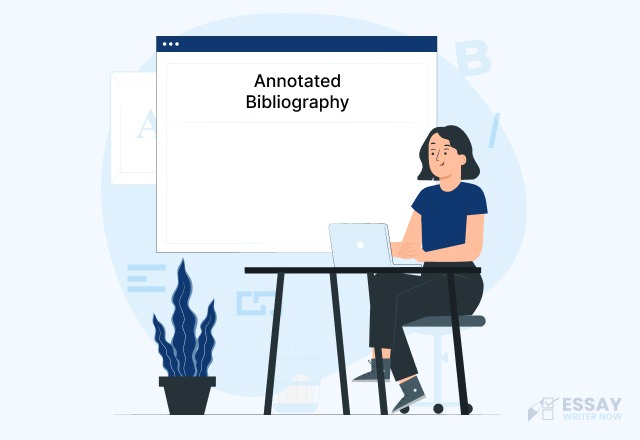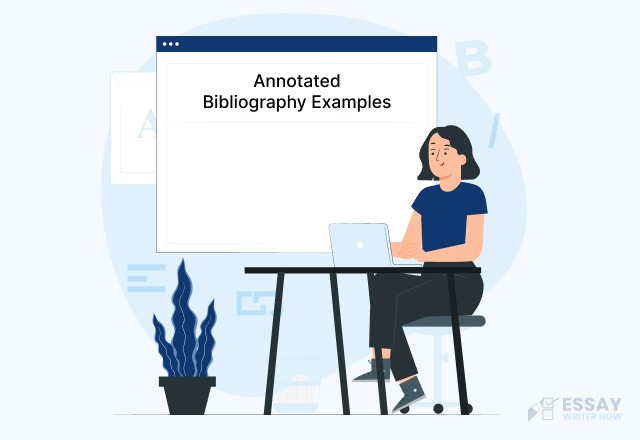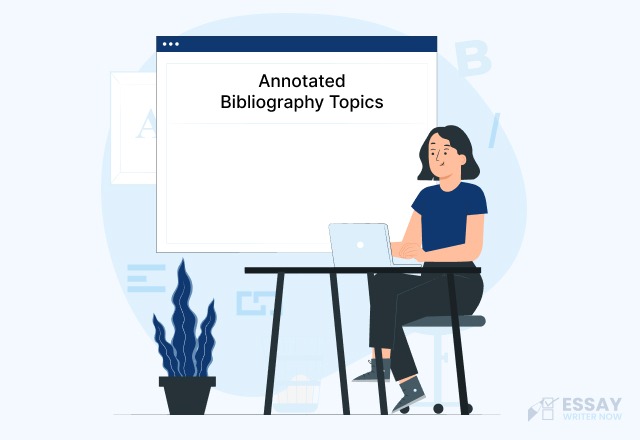What Is An Annotated Bibliography?
An annotated bibliography is a list of sources that includes a brief summary and evaluation of each source. Unlike a standard bibliography, which only lists the sources you used, an annotated bibliography provides additional details about each source.
For each entry, you include:
- Citation: A full reference to the source in a specific format, such as APA, MLA, or Chicago style.
- Annotation: A short paragraph that describes the source’s content, evaluates its reliability, and explains its relevance to your research.
The purpose of an annotated bibliography is to give readers an understanding of the quality and significance of each source and how it contributes to your research. It helps you organize your research, show the breadth of your sources, and provide a clearer picture of how each source fits into your overall project.
What Is An Annotated Bibliography APA?
An American Psychology Association annotated bibliography is a list of sources with annotations that provide additional information about each source. These annotations can be summaries, evaluations, or reflections. Unlike a regular bibliography, this type may be created as its own paper, rather than just a part of a research paper.
Formatting An Annotated Bibliography APA
Formatting an annotated bibliography APA involves following specific guidelines to ensure clarity and consistency. Here’s a more detailed look at each aspect:
Page Layout
Page Numbering: Your page numbers should be aligned to the right side of the page. This helps keep your document organized and makes it easier for readers to navigate.
Margins: Set your document margins to one inch on all sides. This standard margin ensures that your bibliography looks neat and is easy to read.
Spacing: Use double spacing throughout your document. This includes the space between lines of text and the space between different entries. Double spacing helps improve readability and provides room for comments or corrections.
Running Header
Inclusion: While the running header is often optional in an annotated bibliography, you might need to include it depending on your instructor’s requirements. A running header usually consists of a short title and page number.
Format: If you include a running header, ensure it is formatted correctly according to APA guidelines. For most annotated bibliographies, it’s enough to have just the page number in the header.
H3- Title
Centering: The title of your document should be centered at the top of the page. Write "Annotated Bibliography" in bold font. This title clearly indicates the content of your paper and distinguishes it from other types of documents.
Indentation
Hanging Indent: For citations, use a hanging indent. This means that the first line of each citation is flush with the left margin, and all subsequent lines are indented by half an inch. This helps each citation stand out and improves the overall readability.
Annotation Indentation: For annotations, indent the text five spaces from the left margin. This creates a clear separation between the citation and the annotation, making it easier for readers to follow.
Creating Your Citations In APA
Citations in an annotated bibliography APA need to follow the specific format for different types of sources. Here's a more detailed look at how to format citations for books and journal articles:
Books
Format: Author, A. A. (Year). Title of work: Capital letter also for subtitle. Publisher.
Example: Smith, J. A. (2020). Understanding the Mind: A Study of Cognitive Psychology. Academic Press.
Explanation: List the author’s last name first, followed by their initials. Include the publication year in parentheses. Italicize the book title and only capitalize the first word of the title and subtitle. Finish with the name of the publisher.
Journal Articles
Format: Author, A. A. (Year). Title of article. Title of Periodical, volume number(issue number), pages.https://doi.org/xx.xxx/yyyy
Example: Brown, L. M. (2021). Cognitive development in early childhood. Journal of Psychology, 58(4), 45-60. https://doi.org/10.1234/jpsych.2021.0045
Explanation: For journal articles, start with the author’s last name and initials. Include the publication year in parentheses, followed by the article title in sentence case (only the first word and proper nouns capitalized). Italicize the journal title and volume number, and include the issue number (if applicable) in parentheses. List the page range and, if available, provide the DOI link.
Composing An APA Annotation
Annotations are short paragraphs that follow each citation, providing additional context and evaluation. Here’s how to effectively compose an annotation:
Authority Of The Source
Discuss the author’s qualifications and why they are a reliable source. Mention their background, expertise, or any relevant credentials that support the credibility of their work.
Overview
Provide a brief summary of the main points or arguments presented in the source. This helps readers understand the content and scope of the source without having to read it in full.
Value To Your Research
Explain how the source contributes to your research. This might include its relevance to your topic, its support for your thesis, or its usefulness in providing background information.
Length
Annotations are generally 100-300 words long, depending on the guidelines provided by your instructor. Make sure to be concise yet comprehensive in covering the key aspects of the source.
Organizing An APA Bibliography
Organizing your annotated bibliography APA properly is essential for clarity and professionalism. Here’s a more detailed guide on how to achieve this:
Alphabetizing Entries
Letter-by-Letter System: Arrange your entries alphabetically by the author’s last name. This means you should place entries in order based on each letter of the author’s last name, just as you would in a typical reference list.
Multiple Authors: If a source has multiple authors, use the first author’s last name to determine the order. For example, if you have both “Smith, J. A.” and “Smith, L. B.”, list “Smith, J. A.” before “Smith, L. B.”.
No Author: If a source doesn’t have an author, use the title of the work to determine its placement. Alphabetize by the first significant word in the title (ignore “A,” “An,” or “The” at the beginning of the title).
Consistency In Formatting
Uniform Appearance: Ensure that all entries are formatted consistently. This means using the same font, size, and style throughout your bibliography. Consistent formatting helps maintain a professional appearance and makes your bibliography easier to read.
Indentation: Apply the hanging indent correctly for each citation. This involves indenting the second and subsequent lines of each citation by half an inch. Ensure this format is consistent across all entries.
Spacing: Use double spacing throughout your document. This includes the space between citations and annotations, as well as the space between different entries.
Try using an annotated bibliography template to make sure you can maintain consistency in your formatting.
The Benefits Of An Annotated Bibliography APA
An annotated bibliography APA is a valuable tool in academic writing that provides a comprehensive overview of sources relevant to a research topic. Here’s a look at the key benefits of using an annotated bibliography APA:
Enhanced Understanding Of Sources
Creating an annotated bibliography involves summarizing and evaluating each source. This process helps researchers gain a deeper understanding of their sources and their relevance to the research topic. By critically assessing each source, researchers can better grasp the strengths, weaknesses, and biases within the literature.
Improved Research Organization
An annotated bibliography helps organize research materials systematically. Each entry includes a citation followed by a brief annotation that summarizes the content and evaluates the source. This organization makes it easier for researchers to track their sources, identify gaps in the literature, and ensure that their research is thorough and well-rounded.
Facilitates Efficient Review
For readers and reviewers, an annotated bibliography provides a quick reference to the sources used in a research project. The annotations offer concise summaries and evaluations, allowing others to quickly assess the relevance and credibility of each source without having to read through every reference in detail.
Strengthens Academic Writing
Incorporating an annotated bibliography into academic work demonstrates a researcher’s commitment to thorough research and critical analysis. It shows that the researcher has engaged deeply with the sources and has a clear understanding of how each source contributes to their research. This thoroughness can enhance the overall quality and credibility of the research paper.
Supports Future Research
Annotated bibliographies are valuable for future research projects. Researchers can revisit their annotations to refresh their memory on how specific sources were used and to identify potential avenues for further investigation. This can be particularly helpful when building on previous work or exploring new aspects of a topic.
Aids In Citation Management
APA style annotations follow a specific format, which helps researchers maintain consistency in their citations. This can be especially useful when managing a large number of sources, ensuring that each reference is correctly cited and formatted according to APA guidelines.
Sample Annotated Bibliography APA Entries
Here are examples of APA 7th edition annotated bibliographies:
Website
Citation: Anderson, T. (2023, January 8). The basics of climate change: An introductory guide. National Geographic.https://www.nationalgeographic.com/environment/article/climate-change |
Annotation: Anderson’s article provides a foundational understanding of climate change, including its causes, effects, and potential solutions. The National Geographic website is a reputable source known for its authoritative content on environmental issues. This article is particularly useful for my research on climate change impacts, as it offers a clear and concise summary of the topic, backed by recent data and expert opinions. The accessible writing style and comprehensive overview will help frame my discussion on climate change adaptation strategies. |
Book
Citation: Davis, M. J. (2021). The history of modern economics. Oxford University Press. |
Annotation: Davis’s book traces the evolution of economic theories from the early 20th century to the present. As an established economist, Davis provides a thorough examination of key economic theories and their historical context. This book is valuable for my research on economic policy development, as it offers a detailed exploration of how modern economic thought has evolved. The book’s historical perspective and analysis of influential economists will help in understanding the foundation of current economic policies. |
Article In Journal
Citation: Lee, S. K., & Martinez, J. L. (2022). Advances in artificial intelligence: A comprehensive review. Journal of Computer Science and Technology, 39(4), 450-468. https://doi.org/10.1016/j.jcst.2022.06.009 |
Annotation: Lee and Martinez’s article reviews recent advancements in artificial intelligence, focusing on technological innovations and applications. The authors, both experts in computer science, provide an in-depth analysis of the latest research and developments in AI. This article is crucial for my study on AI applications in various industries, as it summarizes current trends and breakthroughs. The detailed review of technological progress and future directions will support the theoretical framework of my research on AI’s impact on business practices. |
Annotated Bibliography APA Examples
Here are some annotated bibliography examples you can use as a reference point:
In conclusion, creating an annotated bibliography in APA style might seem tricky at first, but by following these simple steps, you can tackle it with confidence. From understanding formatting basics to writing clear annotations, this guide equips you with all you need to build a strong foundation for your research.
Remember, an annotated bibliography isn't just a list of sources. It's a powerful tool that helps you organize your research, understand your sources better, and ultimately write a stronger academic paper. So next time you face an APA annotated bibliography, take a deep breath, follow these steps, and watch your research project flourish!






